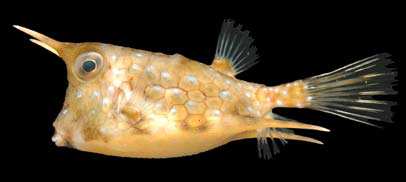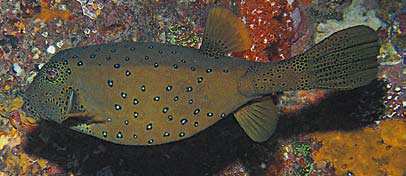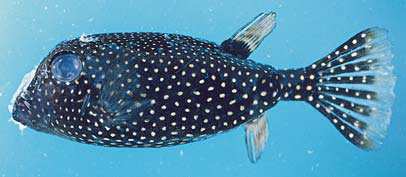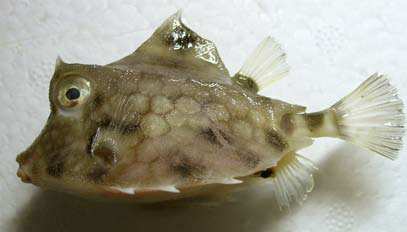OSTRACIIDAE
Boxfishes
By Keiichi Matsuura
 Lactoria cornuta |
 Ostracion cubicus |
 Ostracion meleagris |
 Tetrosomus gibbosus |
|
Small to medium-sized fishes, never more than 45 cm, with wide body nearly completely enclosed in a carapace or cuirass formed of enlarged, thickened scale plates, usually hexagonal in shape and firmly sutured to one another (less so on cheek to allow for breathing movements). The carapace has openings for the mouth, eyes, gill slits, and fins, and for the flexible caudal peduncle; it is either triangular (flat on bottom and sharp-crested above) or rectangular in shape, although sometimes relatively pentangular. Mouth small, terminal, with fleshy lips; teeth moderate, conical, usually less than 15 in each jaw. Gill openings relatively short, vertical to oblique slits in front of pectoral-fin bases. Spiny dorsal fin absent; most dorsal-, anal- and pectoral-fin rays branched; pelvic fins absent. Scale-plates often with surface granulations and sometimes prolonged into prominent carapace spines around eye or along the ventrolateral or dorsal surfaces of the body; scales above pectoral-fin base like the scales of rest of body. Lateral line inconspicuous. Color: variable, with general ground colors ranging from gray to bluish and greenish or, to yellowish and brown, usually with darker or lighter lines, bars, spots, or reticulations. Similar families occurring in the area. No other fishes enclosed in a bony shell. Remarks. occurring on rocky and coral reefs and over sand, weed, or sponge-covered bottoms to depths of 100 m. Secreting a substance when distressed that is highly toxic, both to other fishes and themselves in enclosed areas such as aquarium tanks. |

|
|